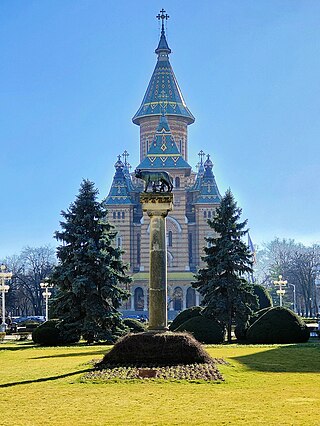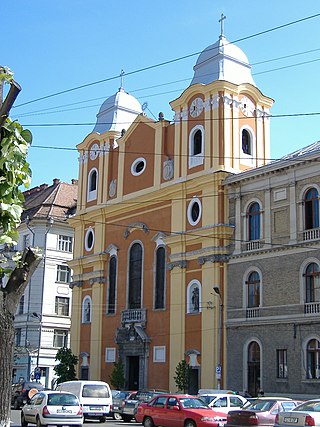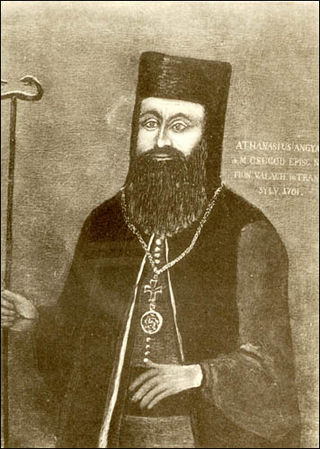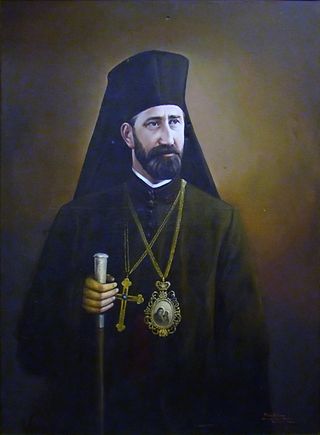

The Church on the Hill (Romanian : Biserica din Deal) is a Romanian Orthodox church located at 10 Bisericii Ortodoxe Street, Cluj-Napoca, Romania. It is dedicated to the Holy Trinity.


The Church on the Hill (Romanian : Biserica din Deal) is a Romanian Orthodox church located at 10 Bisericii Ortodoxe Street, Cluj-Napoca, Romania. It is dedicated to the Holy Trinity.
In the late 18th century, several wealthy Aromanian families lived in Cluj; the nearest Orthodox church, which they attended only on major holidays, was located in Someșeni. Thus, in 1788, two merchants petitioned count Ádám Teleki, royal commissioner of Joseph II in the Principality of Transylvania, asking permission to build an Orthodox church inside the city. [1]
The following year, the town council rejected the request, arguing that only previously established denominations could build. A new petition was issued, and a census in February 1790 identified 129 Orthodox inhabitants. Upon the government's recommendation, the chancellery in the imperial capital Vienna approved the building the same month. The town council protested in vain that this would increase the local Romanian presence. Thus, the merchants purchased land in the Hajongard area. [1]
The church was built using a Baroque style [2] in 1795–1796, with help from the Romanians of Brașov and Wallachia. The first liturgy was celebrated at Christmas 1796, when the church was consecrated. The church is small, 19 meters long by 9 meters wide, with a spire reaching 19 meters. The vestibule is rectangular, the nave octagonal, the choir narrow; the altar is semicircular in the interior and polygonal in the exterior. The iconostasis was painted in 1796 by the well known Constantin the Painter, a deacon from Șcheii Brașovului and sent as a gift by the merchants of Brașov. [1]
From 1796 to 1932, it was the only Orthodox church in Cluj. Vasile Moga was enthroned bishop there in 1811, but political pressure soon forced him to leave for Rășinari. In 1921, when Nicolae Ivan became the first bishop of the Vad, Feleac and Cluj Diocese, the church became his cathedral, holding that status until 1933, when the Dormition Cathedral opened. [1]
The archpriest's office has operated out of the church since 1818. Several priests are buried in the little cemetery in front of the church. Several intellectuals of the interwar period were parishioners, including Victor Papilian, Lucian Blaga and Dumitru D. Roșca. The church underwent restoration in 1919, when a memorial written by the then-priest in 1877 was discovered in the spire. As the building was facing degradation, a thorough set of repairs was carried out between 2003 and 2010. [1]
The church is listed as a historic monument by Romania's Ministry of Culture and Religious Affairs. [3]

The Romanian Greek Catholic Church or Romanian Church United with Rome is a sui iuris Eastern Catholic Church, in full union with the Catholic Church. It has the rank of a Major Archiepiscopal Church and it uses the Byzantine liturgical rite in the Romanian language. It is part of the Major Archiepiscopal Churches of the Catholic Church that are not distinguished with a patriarchal title.

The St. Michael's Church is a Gothic-style Roman Catholic church in Cluj-Napoca. It is the second largest church in the geographical region of Transylvania, Romania. The nave is 50 meters long and 24 meters wide, the apse is 20×10 m. The tower with its height of 76 meter is the highest one in Transylvania.

The Orthodox Cathedral, also known as the Metropolitan Cathedral, is a Romanian Orthodox church in Timișoara. The cathedral is the seat of the Archbishopric of Timișoara and the Metropolis of Banat. It is dedicated to the Three Holy Hierarchs, Basil the Great, Gregory the Theologian and John Chrysostom.

The Dormition of the Theotokos Cathedral is the most famous Romanian Orthodox church of Cluj-Napoca, Romania. Built in a Romanian Brâncovenesc style, a synthesis of Renaissance and Byzantine architecture, it lies on the Avram Iancu Square, together with the Cluj-Napoca National Theatre and the Avram Iancu Statue.

The Transfiguration Cathedral, also known as the Minorites' Church, was donated in 1924 by the Holy See to the Romanian Greek-Catholic Church to serve as the Cathedral of the Cluj-Gherla Eparchy, after the move of the Eparchy's center from Gherla to Cluj.

The Piarist Church, located at 5 Str. Universității, Cluj-Napoca, Romania, and dedicated to the Holy Trinity, was the first Roman Catholic church built in Transylvania after the Protestant Reformation, as well as the province's first Baroque church building. Among the city's more notable edifices, it served as a prototype for numerous other churches in Transylvania. It features a strong contrast between the sober exterior and a very well-decorated, almost exuberant interior. A statue of the Virgin Mary stood in front of the church until 1959, when the Communist authorities moved it to another part of the city.

Atanasie Anghel Popa was a Romanian Greek-Catholic bishop of Gyulafehérvár between 1698 and 1713. He was the successor to Teophilus Seremi in the seat of Mitropoliei Bălgradului. Through his continued efforts, he perfected the union of the Romanians living in Transylvania and other parts of Hungary with the Catholic Church.

The Holy Trinity Cathedral, Sibiu, located at 35 Mitropoliei Street, Sibiu, Romania, is the seat of the Romanian Orthodox Archbishop of Sibiu and Metropolitan of Transylvania. It was built in the style of a Byzantine basilica, inspired by Hagia Sophia, with the main spires influenced by Transylvanian church architecture and Baroque elements.

The Holy Trinity Church, Sighişoara is a Romanian Orthodox Church located on the northern bank of the Târnava Mare River, Sighişoara, Romania. As the seat of an archpriest and not a bishop, it is a church and not technically a cathedral, but is commonly referred to as such.

Demetriu Radu was between 1897 and 1903 the Greek Catholic Bishop of Lugoj, and from 1903 to 1920 the Greek Catholic Bishop of Oradea Mare.

Nicolae Colan was an Austro-Hungarian-born Romanian cleric, a metropolitan bishop of the Romanian Orthodox Church. From a peasant background, Colan completed high school in Brașov, followed by a period of wandering during World War I that saw him in Sibiu, Bucharest, Moldavia, Ukraine and ultimately Bessarabia, where he advocated union with Romania. After the war, he completed university and taught New Testament theology at Sibiu from 1924 to 1936. Entering the clergy in 1934, he soon became bishop at Cluj, remaining there when Northern Transylvania temporarily became Hungarian territory during World War II. In 1957, he advanced to Metropolitan of Transylvania, an office he held for the final decade of his life.

Irineu is a former bishop of the Orthodox Church of America, the Auxiliary Bishop of Dearborn Heights, vicar of the Romanian Orthodox Episcopate of America. He was consecrated on November 2, 2002. Since June 29, 2017 he is no longer part of the ROEA Diocese and the OCA.

Vasile Moga was an Imperial Austrian ethnic Romanian bishop of the Romanian Orthodox Church. A native of Sebeș, he was a parish priest for some years before being made bishop of Transylvania. The first Romanian to hold this office in over a century, he served for over three decades. Living in Sibiu during this period, he worked both to improve the spiritual and educational foundations of the diocese and to secure additional rights for the province's Romanians.

The Dârste Church is a Romanian Orthodox church located at 255 Calea București, Brașov, Romania. Located in Dârste, a former village that is now a district of Brașov, it is dedicated to the Holy Trinity.

The Tocile Church is a Romanian Orthodox church located at 57 Vasile Saftu Street, Brașov, Romania. Located in the Tocile section of Șcheii Brașovului, it is dedicated to the Holy Trinity.

St. George's Church is a Romanian Orthodox church located at 1 Piața Andrei Șaguna, Sfântu Gheorghe, Romania. It is dedicated to Saint George.

The Wooden Church is a Romanian Orthodox church located at 13 Mitropolit Andrei Șaguna Street in Târgu Mureș, Romania. It is dedicated to the Archangel Michael.

The Wooden Church is a Romanian Orthodox church located at 5 Măcieșului Street in Reghin, Romania. It is dedicated to Saint Nicholas.

Teofil Herineanu was an Austro-Hungarian-born Romanian cleric.